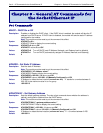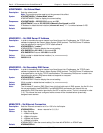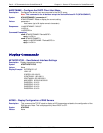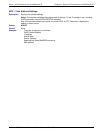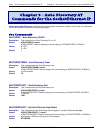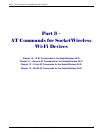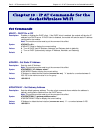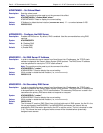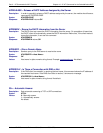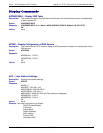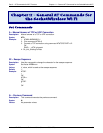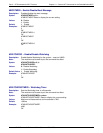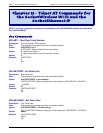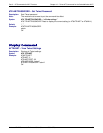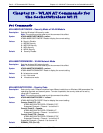
Part 3 – AT Commands for Wi-Fi Devices Chapter 10 – IP AT Commands for the SocketWireless Wi-Fi
Universal IP AT Commands Reference Guide (Document S000457K) 58
#IPNETMASK – Set Subnet Mask
Description: Sets the subnet mask.
Note: The module must be reset to put the command into effect.
Syntax: AT#IPNETMASK="<Subnet Mask value>"
AT#IPNETMASK? Read or display the current setting.
Values: IP Address in dotted decimal notation (xxx.xxx.xxx.xxxx). "x" = a number between 0-255.
Default: 255.255.255.0
#IPDNSSERV – Configure the DNS Server
Description: Enables the DNS server. By default, DNS is enabled. Use this command before using DNS
services.
Syntax: AT#IPDNSSERV
Values: 0 - Disables DNS
1 - Enable DNS
Default: 1 (Enable DNS)
#DNSSERV1 – Set DNS Server IP Address
Description: In order to translate the server names from literal format into IP addresses, the TCP/IP stack
software implements the Domain Name System (DNS) protocol. The DNS Server IP address
must be specified for use by the TCP/IP stack software.
Note: The module must be reset to put the command into effect.
Syntax: AT#DNSSERV1="<value>"
AT#DNSSERV1? Read or display the current setting.
Values: 32-bit number in dotted-decimal notation (i.e., xxx.xxx.xxx.xxx).
Default: 202.56.215.6
#DNSSERV2 – Set Secondary DNS Server
Description: In order to translate the server names from literal format into IP addresses, the TCP/IP stack
software implements the Domain Name System (DNS) protocol. The DNS Server IP address has
to be specified for use by the TCP/IP stack software. This secondary DNS server is used in the
case where the primary DNS server does not respond to a request.
Syntax: AT#DNSSERV2="<value>"
AT#DNSSERV2? Read or display the current setting.
Values: 32-bit number in dotted-decimal notation (i.e., xxx.xxx.xxx.xxx).
Default: 202.56.230.6
Note: The Universal IP resolver (DNS Client) has a list that holds up to 4 DNS servers, the first 2 in the
list are populated by the #DNSSERV1 and #DNSSERV2 commands, the 3rd and 4th are
populated by DNS information provided by the ISP or cellular carrier. The list is checked in order
(1-4). This means that user configured name servers will be checked before dynamically
assigned name servers.



